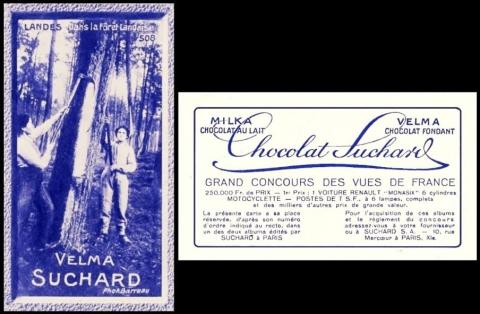
This card is very odd, because it shows a forest, and if you look closely the nearest man to the front is scraping away the bark of the tree. That begs a bit of a question, for it could mean they are forestry workers doing a bit of remedial work to help the tree by removing certain unwanted insects which have burrowed beneath the bark and are destroying the tree; a very skilful job, for if you remove too much bark, or in the wrong place, or completely cut a band around the trunk, known as a ring band, then the tree will probably die, because the bark is a vital component thereof, and amongst many things, it transports the water and nutrients around the tree`s internal systems, and it cannot do that without a continuous passage up and around the tree.
On the other hand, there is an alternative to what may be going on here, and that is a curious practice called bark stripping. It is illegal, and harmful to the tree, but the belief in many countries is that bark can be used as medicine. This is frowned upon by scientific studies who say that it is no use for that, and especially not when stripped from the base of the tree, which is harder and less likely to contain useful substances - though in saying this they have inadvertently suggested that higher up there are such things. Now if you look again at the card, you will see that the stripping is mainly being carried out at arms length above the head, though a long strip has been cut, maybe as a test.
The location is given as "Dans la Foret Landaise" - or in the forest of Landaise. This area is huge, going into two separate areas of France, and within it are the sources of several rivers. The trees there are maritime pine, and they were actually grown specifically to combat erosion, as well as to allow the roots to cleanse the rather dense and patchy soil.
However there is something rather special about maritime pine, and that is that the bark is indeed used for medicine, both legally, and secretly. Its main uses are in relieving asthma, and also for improving the immune system and the circulation of blood through the human body. It can also be used to prevent infections, and, only fairly recently, is being studied as a possible relief for ADHD sufferers.
I thought I would struggle to identify this but I took a chance and put Suchard in the search facility of The Trading Card Database/Suchard/P2 and found it actually has this set, along with many other variants, those being listed at Suchard/Sets.
This is quite a hard issue to sort out, for there are several sets that look alike. The earliest one, issued in 1909, should not be too confusing for too long, as it deals with La Suisse, or Switzerland, and they also give a Swiss address, Neuchatel. There are 240 cards in that set. The other two sets are of France, and give an address in Paris. These are both called "La France Pittoresque" (Picturesque France), and they do look alike from the front. However, there are fairly easy ways to identify which series the card you just found in your job lot comes from.
The way to tell the two series apart is through the numbering system, because the first series, issued in 1928, is of three hundred cards, starting at card one, and the second series, issued in 1929, carries on, and starts at 301.
There are then different back designs for each series. Back number one is ours, all words, and with a title of "Grand Concours des Vues de France". This relates to a competition, in which the first prize was actually a car, a Renault "Monasix" six cylinder Motocyclette. This was a pretty new car, which was first manufactured in 1927, but had a few problems, not the least of which was the fact that the small engine was insufficient for the size of the car, and it was often hard to control. In 1932 it disappeared from the sales lists, though it remained popular as a local taxi, and thousands of them plied their trade around the streets of Paris, for many decades after they were no longer produced.
The second back is very similar except that the "Grand Concours" (the competition) is not there, this just says "Collection des vues de France". I imagine that this was issued either before the competition had started or when it had been won. Then there is a third back, which shows a big map of France, though it is but a outline view of the country infilled in blue, with only one town, Paris, shown.
"Velma", by the way, was chocolate fondant, but to make things even harder there are several other brands dotted around through the sets.
